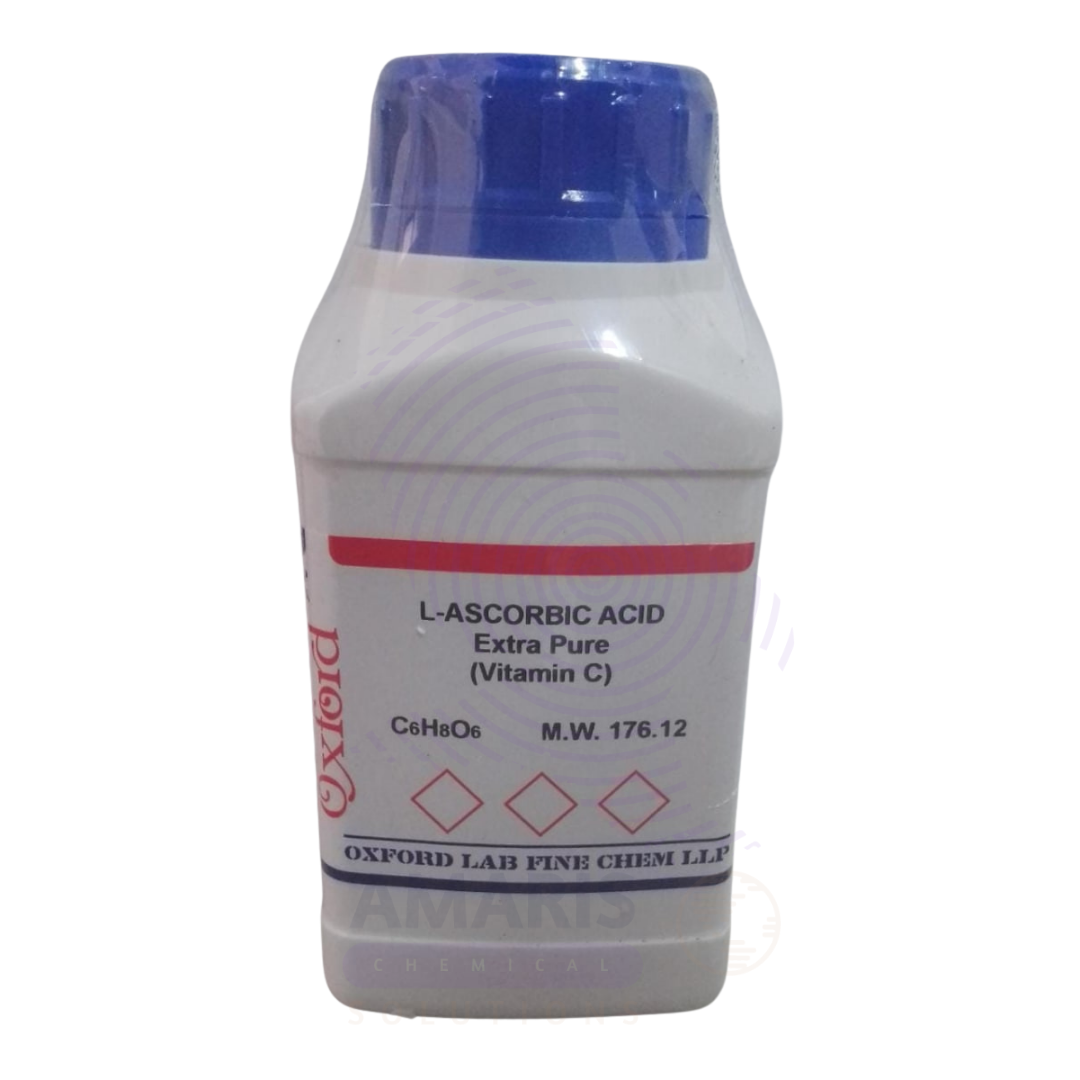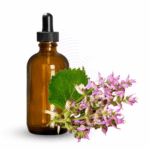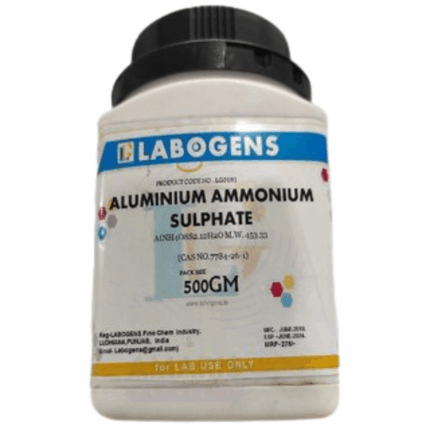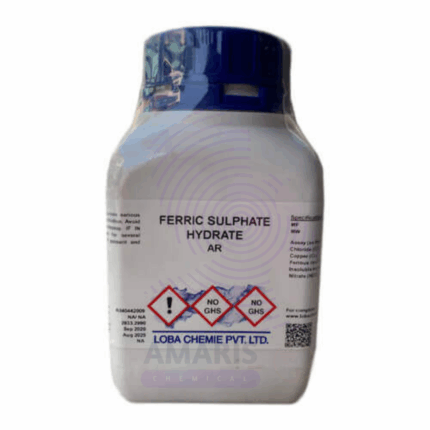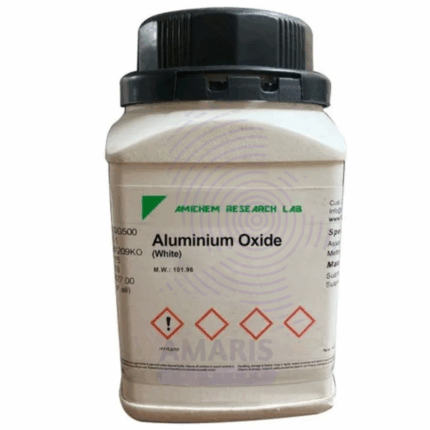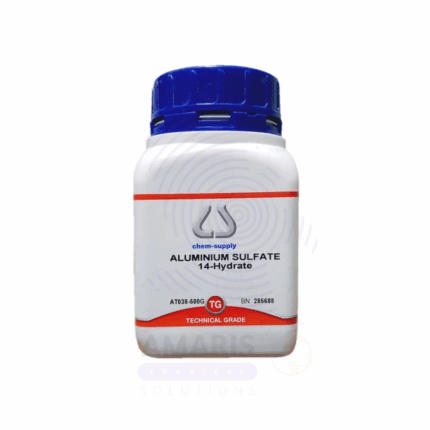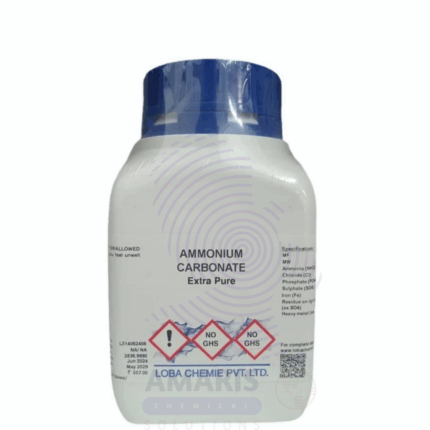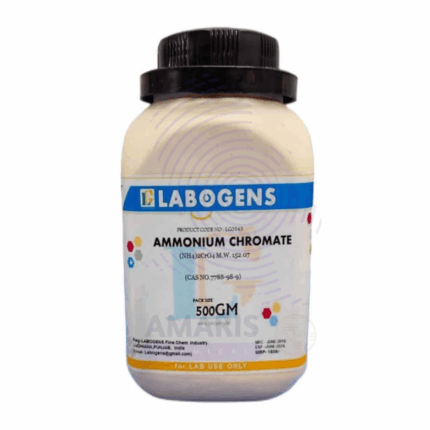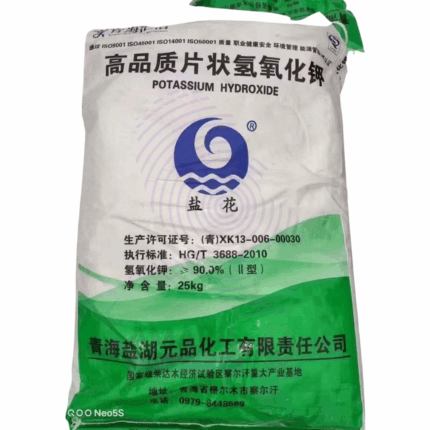Ascorbic Acid Extra Pure
$ 17.00 Original price was: $ 17.00.$ 16.89Current price is: $ 16.89.
Ascorbic Acid Extra Pure, commonly known as Vitamin C, is a high-purity, white to slightly yellow crystalline powder widely used in laboratory settings for analytical, biochemical, and pharmaceutical research. It functions as a potent reducing agent and antioxidant, making it valuable in redox titrations, radical scavenging assays, and studies of oxidative stress and enzyme activity. Ascorbic acid is also used in food chemistry experiments and as a stabilizer in formulations prone to oxidation. The extra pure grade ensures minimal contaminants, supporting precise and reproducible results in sensitive applications. It should be stored in tightly sealed containers, protected from light, heat, and moisture to preserve its stability and effectiveness.
Ascorbic Acid Extra Pure uses
Primary Uses
- Reducing Agent in Redox Titrations
- Acts as a mild and selective reducing agent, especially in iodometric titrations, where it reduces iodine (I₂) to iodide (I⁻).
- Antioxidant in Biochemical and Food Chemistry Studies
- Commonly used to prevent oxidation of sensitive molecules like polyphenols, enzymes, and fats in research on degradation and stability.
- Standard for Vitamin C Quantification Assays
- Serves as a reference compound in DCPIP titrations, spectrophotometric assays, and nutritional analysis of foods.
- Model Compound in Redox Kinetics and Mechanism Studies
- Ideal for teaching and research on reaction kinetics, electron transfer, and radical scavenging.
- Buffer and pH Modifier in Biochemical Solutions
- In low concentrations, it can help maintain mildly acidic pH and support enzyme activity in biological experiments.
Secondary Uses
- Preservative in Sample Preparation and Storage
- Added to aqueous or biological samples to prevent oxidative degradation during storage or analysis.
- Reagent in Plant and Tissue Culture Media
- Protects cells from oxidative stress, and stimulates growth in some plant tissue culture formulations.
- Chelating Agent for Metal Ions
- Chelates Fe³⁺ and other metal ions, sometimes used in metal transport, uptake, or redox balance studies.
- Control Compound in Antioxidant Screening
- Frequently used as a benchmark antioxidant when evaluating radical scavenging activity of other substances (e.g., DPPH assay).
- Demonstration of Non-Enzymatic Browning Inhibition
- Employed in food chemistry teaching labs to study Maillard reaction suppression or delay in fruit/vegetable oxidation.
| PACK SIZE |
100 grams Plastic Tin |
|---|
1. Basic Identification Attributes
- Chemical Name: Ascorbic Acid
- CAS Number: 50-81-7
- HS Code: 29362700 (Vitamins and their derivatives – Ascorbic acid and its salts)
- Molecular Formula: C₆H₈O₆
- Synonyms:
- Vitamin C
- L-Ascorbic acid
- 3-Keto-L-gulofuranolactone
- L-threo-hex-2-enono-1,4-lactone
2. Physical & Chemical Properties
- Physical State: Solid (crystalline powder)
- Color & Odor: White to slightly yellow; odorless with slightly acidic taste
- Boiling Point: Decomposes before boiling
- Melting Point: ~190–192 °C (with decomposition)
- Density/Specific Gravity: ~1.65 g/cm³
- Solubility:
- Water: Freely soluble (~330 g/L at 20 °C)
- Alcohol: Slightly soluble
- pH Level: ~2.1–2.6 (in 5% aqueous solution)
- Vapor Pressure: Negligible
- Flash Point: Not flammable
- Autoignition Temperature: Not applicable
- Viscosity: Not applicable
3. Safety & Hazard Attributes
- Hazard Class (GHS):
- Not classified as hazardous under GHS
- May cause mild eye or skin irritation in sensitive individuals
- NFPA Ratings:
- Health: 0
- Flammability: 0
- Reactivity: 0
- Exposure Limits:
- No established OSHA or ACGIH limits
- Reactivity:
- Sensitive to air, heat, and light (oxidizes readily)
- Incompatible with strong oxidizing agents and alkalis
4. Storage & Handling Attributes
- Storage Conditions:
- Store in airtight container, in a cool, dry, dark place
- Protect from light and moisture
- Incompatible Materials:
- Strong oxidizers (e.g., chlorine, nitrates)
- Bases (promote degradation)
- Container Type:
- Amber glass or opaque plastic
- Shelf Life & Expiration Date:
- ~2 years if stored properly
- Special Handling Requirements:
- Use gloves and avoid exposure to air and moisture during use
5. Regulatory & Compliance Attributes
- Regulatory Status:
- Listed under TSCA, REACH, GRAS (Generally Recognized as Safe for food)
- Hazard Symbols (GHS Pictograms):
- None required for non-industrial handling
- Transportation Restrictions:
- Not regulated as hazardous
- Waste Disposal Method:
- Small amounts can be flushed with water
- Bulk waste: dispose via certified waste facility
6. Environmental & Health Impact
- Ecotoxicity:
- Low toxicity; biodegradable
- Persistence in Environment:
- Degrades rapidly in presence of light and oxygen
- Carcinogenicity/Mutagenicity:
- Not classified as carcinogenic or mutagenic
- Biodegradability:
- Readily biodegradable
SAFETY PRECAUTIONS
- Personal Protective Equipment (PPE):
- Wear lab coat, safety goggles, and nitrile gloves.
- Use in a well-ventilated area or under a fume hood if handling large quantities or powders.
- Handling:
- Avoid inhalation of dust and contact with eyes or skin.
- Handle with care to minimize airborne particles.
- Avoid contamination with oxidizing agents or bases—it may degrade the compound.
- Storage:
- Store in a cool, dry, well-ventilated area.
- Keep container tightly sealed, protected from light, moisture, and air (to prevent oxidation).
- Use amber or opaque containers if possible.
- Hygiene Measures:
- Wash hands thoroughly after handling.
- Avoid eating, drinking, or smoking while using the chemical.
- Clean up any spilled powder immediately using appropriate PPE.
FIRST AID MEASURES
- Inhalation:
- Remove person to fresh air.
- Seek medical advice if respiratory irritation occurs (coughing, sneezing, sore throat).
- Skin Contact:
- Wash skin with plenty of water and soap.
- Remove contaminated clothing.
- Seek medical attention if irritation or rash develops.
- Eye Contact:
- Rinse immediately with plenty of clean water for at least 15 minutes.
- Lift eyelids to ensure full flushing.
- Seek medical attention if irritation persists.
- Ingestion:
- Rinse mouth with water.
- Do not induce vomiting.
- Generally considered low toxicity, but seek medical advice if large amounts are ingested or if symptoms occur (diarrhea, cramps).
FIRE FIGHTING MEASURES
- Suitable Extinguishing Media:
- Use dry chemicals, CO₂, foam, or water spray.
- Specific Hazards:
- Ascorbic acid is combustible, though not highly flammable.
- Thermal decomposition can produce:
- Carbon monoxide (CO)
- Carbon dioxide (CO₂)
- Irritating organic fumes
- Protective Equipment:
- Firefighters should wear SCBA (self-contained breathing apparatus) and protective gear.
- Firefighting Instructions:
- Cool containers with water spray.
- Avoid breathing smoke or vapors.
- Prevent runoff—though not highly toxic, ascorbic acid may cause pH changes in water bodies.
Related products
Aluminium Ammonium Sulphate Extra Pure
Aluminium Ferric Sulphate Extra Pure
Aluminium Metal Fine Extra Pure
Aluminium Oxide Extra Pure
Aluminium Sulphate Hydrous Extra Pure
Ammonium Carbonate Extra Pure
Ammonium Carbonate Extra Pure is a high-quality, white crystalline solid widely used across various scientific, industrial, and food-related applications. Manufactured to stringent purity standards, this compound is ideal for laboratories and processes that demand high-grade reagents. With its characteristic ammonia-like odor and ability to decompose upon heating, ammonium carbonate plays a versatile role in both chemical reactions and physical processes.
In aqueous solution, ammonium carbonate breaks down into ammonium bicarbonate and ammonium carbamate, further releasing ammonia (NH₃) and carbon dioxide (CO₂) upon heating. This property makes it especially useful in applications that require controlled gas release or temporary pH modification.


 Preservatives(food)
Preservatives(food) Flavor Enhancers
Flavor Enhancers Acidulants
Acidulants Sweeteners
Sweeteners Antioxidants
Antioxidants Colorants(food)
Colorants(food) Nutraceutical Ingredients (food)
Nutraceutical Ingredients (food) Nutrient Supplements
Nutrient Supplements Emulsifiers
Emulsifiers
 Collectors
Collectors Dust Suppressants
Dust Suppressants Explosives and Blasting Agents
Explosives and Blasting Agents Flocculants and Coagulants
Flocculants and Coagulants Frothers
Frothers Leaching Agents
Leaching Agents pH Modifiers
pH Modifiers Precious Metal Extraction Agents
Precious Metal Extraction Agents
 Antioxidants(plastic)
Antioxidants(plastic) Colorants (Pigments, Dyes)
Colorants (Pigments, Dyes) Fillers and Reinforcements
Fillers and Reinforcements Flame Retardants
Flame Retardants Monomers
Monomers Plasticizers
Plasticizers Polymerization Initiators
Polymerization Initiators Stabilizers (UV, Heat)
Stabilizers (UV, Heat)
 Antifoaming Agents
Antifoaming Agents Chelating Agents
Chelating Agents Coagulants and Flocculants
Coagulants and Flocculants Corrosion Inhibitors
Corrosion Inhibitors Disinfectants and Biocides
Disinfectants and Biocides Oxidizing Agents
Oxidizing Agents pH Adjusters
pH Adjusters Scale Inhibitors( water)
Scale Inhibitors( water)
 Antioxidants(cosmetic)
Antioxidants(cosmetic) Emollients
Emollients Fragrances and Essential Oils
Fragrances and Essential Oils Humectants
Humectants Preservatives
Preservatives Surfactants(cosmetic)
Surfactants(cosmetic) Thickeners
Thickeners UV Filters
UV Filters
 Fertilizers
Fertilizers Soil Conditioners
Soil Conditioners Plant Growth Regulators
Plant Growth Regulators Animal Feed Additives
Animal Feed Additives Biostimulants
Biostimulants Pesticides (Herbicides, Insecticides, Fungicides)
Pesticides (Herbicides, Insecticides, Fungicides)
 Active Pharmaceutical Ingredients (APIs)
Active Pharmaceutical Ingredients (APIs) Excipients
Excipients Solvents(pharmaceutical)
Solvents(pharmaceutical) Antibiotics
Antibiotics Antiseptics and Disinfectants
Antiseptics and Disinfectants Vaccine Adjuvants
Vaccine Adjuvants Nutraceutical Ingredients (pharmaceutical)
Nutraceutical Ingredients (pharmaceutical) Analgesics & Antipyretics
Analgesics & Antipyretics
 Analytical Reagents
Analytical Reagents Solvents(lab)
Solvents(lab) Chromatography Chemicals
Chromatography Chemicals Spectroscopy Reagents
Spectroscopy Reagents microbiology-and-cell-culture-reagents
microbiology-and-cell-culture-reagents Molecular Biology Reagents
Molecular Biology Reagents Biochemical Reagents
Biochemical Reagents Inorganic and Organic Standards
Inorganic and Organic Standards Laboratory Safety Chemicals
Laboratory Safety Chemicals Specialty Laboratory Chemicals(Special Laboratory Equipment)
Specialty Laboratory Chemicals(Special Laboratory Equipment)
 Demulsifiers
Demulsifiers Hydraulic Fracturing Fluids
Hydraulic Fracturing Fluids Scale Inhibitors(oil)
Scale Inhibitors(oil) Surfactants(oil)
Surfactants(oil) Drilling Fluids
Drilling Fluids
 Dyes and Pigments
Dyes and Pigments Bleaching Agents
Bleaching Agents Softening Agents
Softening Agents Finishing Agents
Finishing Agents Antistatic Agents
Antistatic Agents
 Admixtures
Admixtures Waterproofing Agents
Waterproofing Agents Sealants and Adhesives
Sealants and Adhesives Curing Compounds
Curing Compounds Concrete Repair Chemicals
Concrete Repair Chemicals Anti-Corrosion Coatings
Anti-Corrosion Coatings
 Surfactants(cleaning)
Surfactants(cleaning) Builders
Builders Enzymes
Enzymes Solvents (Cleaning)
Solvents (Cleaning) Fragrances
Fragrances
 Electronic Chemicals
Electronic Chemicals Catalysts
Catalysts Lubricants
Lubricants Photographic Chemicals
Photographic Chemicals Refrigerants
Refrigerants Automotive chemicals
Automotive chemicals Pyrotechnic Chemicals
Pyrotechnic Chemicals
 Biodegradable Surfactants
Biodegradable Surfactants Bio-based Solvents
Bio-based Solvents Renewable Polymers
Renewable Polymers Carbon Capture Chemicals
Carbon Capture Chemicals Wastewater Treatment Chemicals
Wastewater Treatment Chemicals
 Pigments
Pigments Solvents(paint)
Solvents(paint) Specialty Coatings
Specialty Coatings Binders/Resins
Binders/Resins Additives
Additives Driers
Driers Anti-Corrosion Agents
Anti-Corrosion Agents Functional Coatings
Functional Coatings Application-Specific Coatings
Application-Specific Coatings
 Fresh Herbs
Fresh Herbs Ground Spices
Ground Spices Whole Spices
Whole Spices Spice Blends
Spice Blends Dried Herbs
Dried Herbs
 Leavening Agents
Leavening Agents Dough Conditioners
Dough Conditioners Flour Treatments
Flour Treatments Fat Replacers
Fat Replacers Decoratives
Decoratives Preservatives(baking)
Preservatives(baking)
 Plasticizers & Softeners
Plasticizers & Softeners Reinforcing Agents
Reinforcing Agents Adhesion Promoters
Adhesion Promoters Vulcanizing Agents
Vulcanizing Agents Antidegradants
Antidegradants Blowing Agents
Blowing Agents Fillers & Extenders
Fillers & Extenders Accelerators & Retarders
Accelerators & Retarders